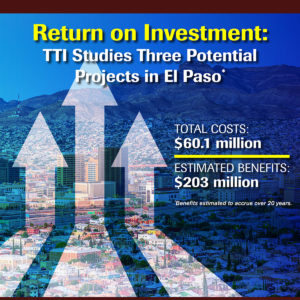Roads, bridges, bike lanes and other transportation infrastructure are not free. Even so, enhancing our transportation system with projects like these can save significant dollars in the long run. As a transportation economist, calculating the cost benefits of a proposed project is one of the most rewarding aspects of my job.
A benefit-cost analysis (BCA) helps show taxpayers the return on their investment. Analyses can provide a completely new way of looking at a project’s promise. For example, we don’t often think that a project can actually cost us money if we don’t do it. Imagine had we not built the Interstate Highway System beginning in the 1950s.
In that day’s dollars, the 41,000-mile highway system cost us a whopping $114 billion. It may only look like a high-speed roadway today, but the system created wealth for our nation by connecting population centers, international border crossings, ports and public transportation. The system proved much safer, more convenient, less congested, and dramatically reduced our transportation costs by improving reliability, connectivity, and the free flow of traffic. That, in turn, increased manufacturing productivity and created an employment boom.
I recently conducted BCAs on three separate El Paso transportation projects as part of grant program application at the U.S. Department of Transportation. The city contracted with the Texas A&M Transportation Institute’s Center for International Intelligent Transportation Research to determine if the projects were worth investing in.
The first analysis looked at a proposed bridge—Sean Haggerty Drive Extension Project—over a northeast region flood plain to connect two El Paso neighborhoods. The project would provide mobility for motorists and first responders, pedestrian and bike routes, access to transit and several neighborhood parks. Vehicle operating cost savings, value-of-time savings, safety benefits and reduced emissions were all possible outcomes thanks to reduced travel times and speeds. Over the 20-year life span of the $18.5 million project, I estimated benefits totaling more than $144 million.
 I conducted another BCA for the proposed Medial Center of the Americas Transit Terminal and Parking Garage. Providing users with parking, passenger information, retail space and bicycle storage, the facility would remove on-street parking and create a reduction in travel. Transit access means less cars, which leads to vehicle operating cost savings and reduced emissions. I estimated benefits at nearly $39 million over the 20-year life cycle of the nearly $32 million project.
I conducted another BCA for the proposed Medial Center of the Americas Transit Terminal and Parking Garage. Providing users with parking, passenger information, retail space and bicycle storage, the facility would remove on-street parking and create a reduction in travel. Transit access means less cars, which leads to vehicle operating cost savings and reduced emissions. I estimated benefits at nearly $39 million over the 20-year life cycle of the nearly $32 million project.
The third BCA was for the Piedras Corridor Project, designed to improve connectivity between I-10 gateways in downtown El Paso and Piedras Street in central El Paso. The benefits accruing from this project all involved safety: 1) reduction of travel lanes and the addition of a dedicated turning lane, 2) curb extensions, or bulb-out median treatments to benefit bicycle and pedestrian traffic, and 3) installation of high-visibility crosswalks. For this $9.6 million project, I estimated $20 million in safety benefits over the 20-year life cycle.
As demonstrated by these projects, savings derived from safety enhancements, vehicle operations, environmental factors and infrastructure improvements are real and measurable. Calculating those savings over a project’s life cycle can help agencies responsible for funding such projects to prioritize them, as well as demonstrate to the public the benefits that accrue from spending tax dollars. These kinds of analyses can also demonstrate how the cost of doing nothing can add up quickly.
Brianne Glover is a TTI associate research scientist and manager of the Institute’s Infrastructure Investment Analysis Program.

